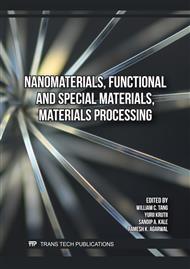p.53
p.59
p.65
p.71
p.79
p.87
p.103
p.119
p.131
Enhancement of Bambusa blumeana Fiber-Reinforced Concrete’s Structural Performance through Alkali-Silane Treatment
Abstract:
Bamboo fibers, as sustainable and renewable resources, have gained significant interest as a reinforcement material in concrete. However, the hydrophilic nature of bamboo fibers limits their compatibility with the concrete matrix. To improve the interfacial bonding and mechanical properties of bamboo fibers, an alkali-silane treatment was employed to modify the fiber surface. This study investigated the effects of alkali-silane treatment, with varying silane concentrations, on the chemical composition, thermal stability, surface morphology, and mechanical properties of bamboo fibers. Treated and untreated fibers were incorporated into concrete composites and subjected to mechanical tests, which include splitting tensile strength, flexural strength, and compressive strength tests. FTIR spectra, TGA curves, and SEM micrographs identified that the alkali-silane treatment of 5% NaOH+10% 3-Methacryloxypropyltrimethoxysilane (KH570) solution was most effective in improving fiber properties and concrete composite performance. The treated fiber-reinforced concrete composites exhibited improved splitting tensile strength (+25.03%), flexural strength (+25.45%), and compressive strength (+26.26%) compared to untreated fiber-reinforced and non-reinforced concrete. These findings demonstrate the potential of alkali-silane-treated bamboo fibers as a promising reinforcement material for sustainable concrete composites.
Info:
Periodical:
Pages:
131-136
Citation:
Online since:
November 2025
Price:
Сopyright:
© 2025 Trans Tech Publications Ltd. All Rights Reserved
Share:
Citation:


